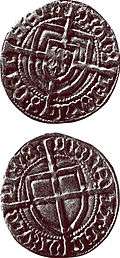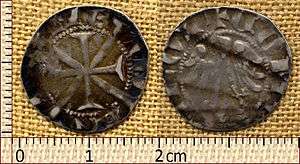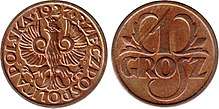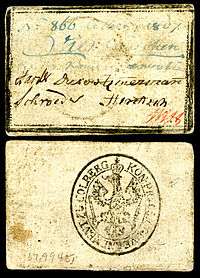Groschen
Groschen (![]()
Names and etymology

The name was introduced in 13th-century France as [denarius] grossus, lit. "thick penny", whence Old French gros, Italian grosso, Middle High German gros(se), Low German and Dutch grōte and English groat. In the 14th century, it appeared as Old Czech groš,[1] whence Modern German Groschen.
Names in other modern European languages include:
- Albanian: grosh
- Bulgarian, Macedonian, Russian, Serbo-Croatian and Ukrainian: грош (groš)
- Dutch: groot
- Estonian: kross
- French: gros
- Hungarian: garas
- Lithuanian: grašis
- Polish: grosz
- Romanian: groș
- Yiddish: גראָשן (grošn)
The qirsh, gersh, grush, γρόσι (grósi) and kuruş are the Arabic, Amharic, Hebrew, Greek and Turkish, names respectively, for currency denominations in and around the territories formerly part of the Ottoman Empire derived from the same Italian origin.
In Polish, the term is also similar to the word for the pea and, as the coins were similar in size and weight, the term might have gained popularity and still remains in use in Poland. It is currently used as a subunit of the złoty.
History

Names like Groschen, grossus/grossi, grosso, grossone, grosz, gros, groš, groat, Groten, garas etc. were used in the Middle Ages for all thick silver coins, as opposed to thin silver coins such as deniers or pennies. Historically it was equal to between several and a dozen denarii.
The type was introduced in 1271 by Duke Meinhard II of Tyrol in Merano. The 1286 example depicted here weighs 1.45 grams (22.4 grains), it is marked with ME IN AR DVS and a Double Cross (obverse), and with DUX TIROL and the Eagle of Tyrol (reverse)
It was minted since the Middle Ages in the following areas:
- Tirol (since 1271)
- England (since 1279, the groat)[2]
- Bohemia (since 1300, the Prague groschen, later adopted by most of the Central European countries)
- Poland (since 1367, the Cracow grosz, 3.2 grams (49 grains) of silver, an equivalent of 12 denarii)
- Moldavia (since the reign of Petru I, 1375–1391)
- The type was also minted during various times in the Duchy of Luxembourg, such as the 22 millimeter 1⁄2 gros produced from 1418 to 1425 under John III the Pitiless, Duke of Bavaria, bearing slightly varying inscriptions of "IOAH DVX BAVAR Z FILIVS" on the obverse, and "MONE NOVA LUCE BURS" on the reverse.[3]
Later the tradition of Groschen was dropped in most states while others continued to mint only coins smaller than the original coin. In Poland for example, since 1526 these included coins of 1⁄2 grosz, 1 grosz, 1 1⁄2 grosz, 2 grosz, 3 grosz, 4 grosz and 6 grosz. Their weight steadily dropped to 1.8 grams (28 grains) of silver and since 1752 they were replaced by copper coins of the same name.
In Germany, the name Groschen (both singular and plural) replaced Schilling as the common name for a 12 pfennig coin. In the 18th century it was used predominantly in the northern states as a coin worth 1⁄24 of a Reichsthaler (equal to 1⁄32 of a Conventionsthaler). In the 19th century, beginning in 1821 in Prussia, a new currency system was introduced in which the Groschen — often called the Silbergroschen (Prussia, from 1821) or Neugroschen (Saxony, from 1840) to distinguish it from older Groschen — was worth 1⁄30 of a Thaler or Taler. Following German unification and decimalisation, the Groschen was replaced by the 10 pfennig coin and Groschen remained a nickname for the 10 pfennig coin until the introduction of the euro. For the same reason, the name Sechser (sixer) remained in use regionally for the half-Groschen coin, 5 Pfennigs.
There is a Beethoven rondo for piano, opus 129 (1795) entitled "Die Wut über den verlorenen Groschen" (literally "The rage over the lost groschen", but known as "Rage over a Lost Penny").
Modern currencies


In recent times, the name was used by three currencies in circulation:
- In Poland, a grosz (plural: grosze or groszy, depending on the number) is a 1⁄100 part of a złoty
- In Austria, a Groschen (plural: Groschen) was a 1⁄100 part of a Schilling (1924–38 and 1945–2001)
- In Turkey, a kuruş is a 1/100 part of lira.
Likewise, in Germany Groschen remained a slang term for the 10 Pfennig coin, thus a 1⁄10 part both of the (West German) Deutsche Mark and the East German Mark. The word has lost popularity with the introduction of the euro, although it can still be heard on occasion, especially from older people.
The Ukrainian and Belarusian word for money, hroshi, ultimately derives from the word "grosh."
In Bulgaria, the grosh (Cyrillic: грош) was used as a currency until the lev was introduced in the 19th century.
In Palestine during the British Mandate, a grush was a coin with a hole in it, valued at 1⁄100 part of a pound (ten mils). It was named after an Ottoman coin. When the pound was replaced by the lira after Israeli statehood in 1948, the name was transferred to a coin (no longer with a hole) worth 1⁄100 of a lira (ten perutot, later one agora). The name persisted for a while after the lira was replaced by the shekel in 1980 (one new agora, worth ten old agorot), but it gradually lost its standing as the name of a certain coin. Now it is a slang for a very small value.[4]
Austria introduced the Groschen in 1924 as the subdivision of the schilling. It was restored, along with the schilling, in 1945 and continued in use until the introduction of the euro in 2002.
See also
| Wikimedia Commons has media related to Groschen. |
- Prague groschen
- Kraków grosz
- Guldengroschen (golden groschen)
- Silbergroschen (silver groschen)
- Neugroschen (new groschen)
- Die Dreigroschenoper, The Threepenny Opera
- Qirsh
- Kuruş
- Groat (coin)
- Venetian grosso
References
- Groschen in the Grimm online dictionary
- Tony Clayton (20 September 1997). "Four Pence". Coins of England and Great Britain. Archived from the original on 7 October 1997.
- http://numisbel.be/1866_11.pdf
- Philologos (pseudonym), "Money Hole", The Forward, November 28, 2003.
